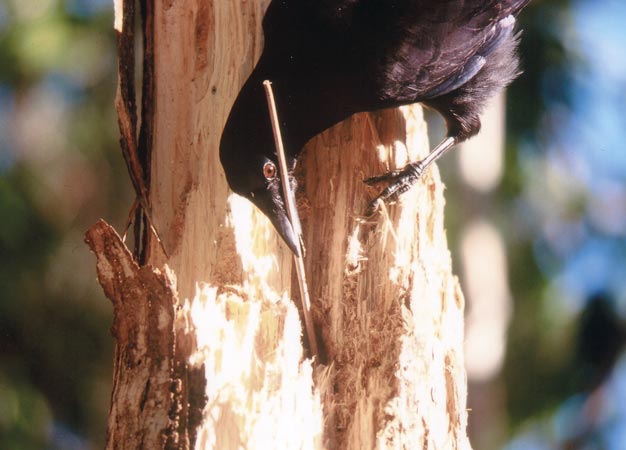Bill structure assists New Caledonian crows in using twig hooks to catch grubs
Published online 26 May 2016

Securely holding a stick tool in its bill, a New Caledonian crow fishes out larvae hidden in decaying wood.
© Gavin Hunt
An international team of researchers discovered the unusual beak shape of the New Caledonian crow (Corvus moneduloides) is an adaptation to the smart bird's use of tools for catching insect prey1.
The beak, with its short, straight upper bill and upturned lower bill, enables the species to grip and precisely manipulate the stick and leaf tools that it makes and uses to hook larvae out of wood. This is the first time scientists have discovered evidence that the physical shape of a non-human species has evolved and changed for better tool manipulation.
"If you look at the bill structure of the New Caledonian crow it is clear to the eye that you have a strange bill structure that is quite different from other crows," says one of the paper's lead authors, Ei-Ichi Izawa of the Department of Psychology at Keio University.
Izawa, a biological psychologist, had previously completed the first crow 'brain atlas' ― a detailed brain analysis and map of a Japanese jungle crow (Corvus macrorhynchos). He also studied the behavior of these bold, city-smart crows.
In 2012, he met ecologist Gavin Hunt from the University of Auckland at a conference in Tokyo, and the two scientists discussed ways to analyze the distinctive beak structure of the more reticent New Caledonian crow. These forest-dwelling crows are endemic to certain islands in New Caledonia and, although their population is declining, are still common.
Hunt had discovered that wild New Caledonian crows made two types of tools, which they used to fish out plump longhorn beetle grubs from tree trunks. The canny birds fashioned hooks from twigs and ripped saw-toothed probes from pandanus leaves that they found in their natural habitat.
Izawa says: "My Japanese colleague Naomichi Ogihara suggested that the morphology of the bill enhanced and improved the use of tools."
The team used computed tomography and a statistical technique known as three-dimensional landmark analysis to compare and measure how the beak structure of the New Caledonian crow differed from that of nine related corvids, and a woodpecker.
They found the New Caledonian crow's upper bill was deeper and shorter than that of the related crow species, and had a straight cutting edge. The thickened lower bill curves slightly upwards, giving the crow a secure grip on its tools. Izawa says: "This shape protects the bill from being bent by the strong forces exerted when probing for food and also allows the bird a clearer view when using tools to fish out prey."
Now Izawa wants to pinpoint how long ago the gene expression related to the 'strange upturned bill' occurred.
Reference
- Matsui, H. et al. Adaptive bill morphology for enhanced tool manipulation in New Caledonian crows. Scientific Reports 6, 22776 (2016). | article